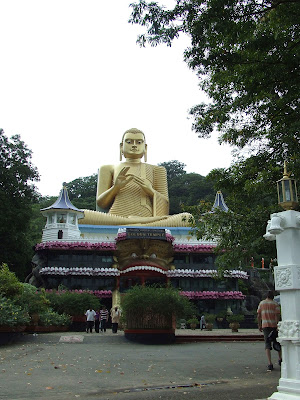Our 43rd wedding anniversary -and another memorable one!
Leaving Kandy around 9am for a leisurely drive to Dambulla we arrived to find that it had been raining and there were few other people around. Excellent !
 |
| Entrance to cave Temples, Dambulla |
 |
| The entrances and columns were added about 1938 |
There are more than 80 caves on the rock but only five are able to be visited. They have been in continuous use as a monastry or religious site for twenty two centuries. First used by a monk who came from India, by the 2nd century BC history records that a monastry flourished here.
 |
| Sam and Lucky under the Bodhi tree |
The first cave, The Cave of the Divine King, [ Devaraja lena ] was the biggest - about 52 metres wide and 22 metres deep. A commanding 14 metre high Buddha haloed statue hewn from rock was surrounded by many others, three of which - also haloed, making identification easy, were also hewn from rock and placed around the walls. Others were made from wood and then plastered over - Lucky showed us where the humidity has caused some of the plaster to fall away, revealing the wood beneath.
Paintings covered the ceiling and walls. In fact I believe that these caves have the largest area of paintings in all of Asia. Lotus flowers, Buddhas . . . . . For some time, all I could do was to walk around in the stillness and fill my eyes. Then I remembered that my camera would provide me with something to hang my memories on!
Of course there were large statues in the three positions. I learned to tell the difference between a sleeping Buddha and a dead one. In the former, the toes are not aligned, the hand is clutching the robe, they eyes are shut, the robe is ruffled and the stomach is pulled in. Thanks to this information from Lucky, I was able to observe all other reclining Buddha statues with more knowledge !
 |
| Toes are not aligned |
The third cave, Maha Alut Vihara or the Great New Monastery, was smaller but it still had around fifty Buddha statues as well as a statue of a King - Kirti Sri Rajasinha, I think. Its ceiling was also decorated with paintings which were done around 1747 - 1780s
 |
| Dambulla Cave Temples |
 |
| Dambulla Cave Temples |
The remaining two caves were much smaller, less cared for. One used to be a store room until it was turned into a shrine.
We spent some time in the caves with Lucky explaining the origins and telling stories and I noticed a great difference between his knowledge and approach when other guides came in and really showed that they did not have the same knowledge and ability. At one point, another visitor stood just apart from us and was listening to Lucky instead of his own guide.
The rain had continued to belt down but we decided to go back down to the car regardless. Reassured by Lucky that there were no leeches in this dry zone, umbrellas up, we took off down the steps minus our shoes,unable to keep up with the fast moving stream of water and mini waterfalls cascading down the steps and swishing at our ankles. Thoroughly soaked we drove into Dambulla and had lunch at Ekanayake Bakehouse. This was a good decision as the bathrooms upstairs were wonderful and we also had a choice of resturants. We ate with the local population downstairs but later also revisited and ate at the Chinese resturant upstairs. Great pitstop !
Lucky then suggested that as we had time we could visit Aukana to see the 46ft Buddha standing in a jungle like environment. This was a very pleasant deviation to plans with a drive through floating paddy fields, along the bank of a large tank, filled to capacity and spilling over and past the scene of the battle to retake Anuradhapura by King Valagambahu near Lalawewa.
The statue itself was really lovely. Carved from a huge rock under orders from King Dhatusena around 5th Century and standing about 14 metres high The Buddha's righ hand gestures a blessing while his left one holds his robe while preparing to cross the river, representing the cycle of rebirth. This statue is much loved by Sri Lankans and once you have seen it, you can recognise copies all over the country. We were able to appreciate in the stillness and peace, ruffled only by a few monkeys in the trees. We had not planned this visit but as we left, I was very glad that we had had such an opportunity to visit this quiet, peacful and significant place.
 |
| Wewa Near Aukana - overflowing! |
 | |
| Temple at Aukana |








No comments:
Post a Comment